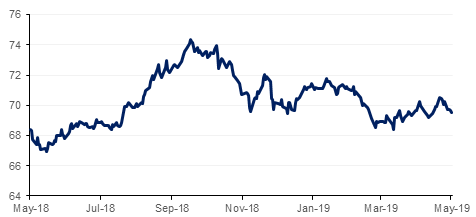
The minutes of the US Federal Reserve’s May policy meeting showed that officials judged their patient approach to interest-rate changes as appropriate for some time. They also raised their growth outlooks and believed that recent softness in prices was temporary. However, we note that the Fed meeting concluded on May 1, several days before the latest escalation of the U.S.-China trade war. Another round of tariffs on a proposed list of $300 billion of Chinese goods could deliver higher U.S. prices, slower growth and a slump in business confidence, which would cement a Fed policy hold. The minutes did point to the limits of tolerance for repeated misses on the inflation target. We believe while they may need to see at least two quarters of low inflation before altering their view, the odds are increasing for abandoning their 2020 rate hike projection.
In the UK, April CPI data was in line with expectations, with headline inflation rising to 2.1% y/y from 1.9% y/y while core CPI remained unchanged. A change in energy tariffs was responsible for the rise in the headline rate, and the BoE had flagged this as likely to be temporary. The BoE indicated in its May Inflation Report that a little more tightening than markets were pricing in would be needed to keep headline CPI near the 2% target rate over the forecast period, although this assumes a smooth and orderly Brexit process, which is looking increasingly uncertain following PM May’s latest attempt to relaunch her withdrawal deal. There is increasing pressure on May to abandon another vote on her Brexit deal and to resign which could usher in a more hardline Brexit supporter as PM, especially if the newly formed Brexit party polls well in EU elections today.
Early counting of votes in India is validating the possibility of Prime Minister Narendra Modi’s ruling coalition heading for another five-year term in office. Markets have opened strongly, with the Sensex and the Nifty indexes rising more than 1% in early trade and the rupee strengthening slightly against the dollar. While Modi is seen as more business-friendly, the incoming government will face an economy with slowing economic growth, 45 year high unemployment level of over 6.1%, budget and current deficits of around 3.4% and 2% of GDP respectively and stress in the banking sector.
 Source: Bloomberg, Emirates NBD Research
Source: Bloomberg, Emirates NBD Research
Treasuries rallied yesterday after minutes of the Federal Reserve’s May policy meeting showed officials judged their patient approach to interest-rate changes would be appropriate for some time.
Yield on 2yr, 5yr, 10yr and 30yrs USTs closed lower at 2.22% (-3bps), 2.18% (-5bps), 2.38% (-5bps) and 2.81% (-3bps) respectively. Safe haven demand on the back of worsening trade situation also benefited the European sovereign bonds with yield on 10yr Gilts and Bunds falling to 1.01% (-7bps) and -0.09% (-2bps) respectively. Credit protection costs were a tad wider amid risk aversion. CDS spread on US IG and Euro Main each widened by circa a bp to 64bps and 67bps respectively.
GCC Bonds benefited from falling benchmark curve with yield on Bloomberg Barclays GCC index closing down by 2 bps to 3.97% even though credit spreads remained unchanged at 167bps.
For a tenth consecutive day, GBPUSD is trading softer following the departure of Cabinet Minister Andrea Leadsom who resigned due to a lack of faith in the government’s ability to deliver a Brexit that keeps the United Kingdom “truly sovereign”. With May’s Premiership looking extremely fragile, the pound has fallen as the markets prepare for the possibility of a pro-Brexit hardliner succeeding as the next Prime Minister.
These declines have taken the price to 1.2645, below the 23.6% one year Fibonacci retracement (1.2684) which is bearish for sterling in the medium term. The 14-day Relative Strength Indicator (RSI) is currently in oversold territory, at 24.94 which means some relief may be seen in the near future as investors take profit on short positions. However, fundamentally and technically the short-term outlook remains bearish for GBP and a decline towards 1.25 cannot be ruled out.
Stocks slid in most markets yesterday as the rhetoric on trade talks became more negative and worrisome. S&P 500 lost 0.28% and Dow Jones was down by -0.39%. Asian bourses are under pressure with Nikkei and Hang Seng down by a significant 0.62% and 1.30% in early morning trades today. That said, Europe seems to be shrugging off the trade fears with FTSE 100 and Euro Stoxx 50 closing up by 0.0.7% and 0.01% respectively.
In contrast, regional GCC markets generally closed stronger. Dubai index was up 1.78% and Tadawul closed up by 0.54%. Also Qatar gained 0.59% and Oman was up 0.49%.
Oil markets sank overnight as the US reported another build in US crude inventories. WTI futures fell 2.5% to close at USD 61.42/b while Brent settled just below USD 71/b, down 1.65%. US stocks rose 4.7m bbl and there were builds across most of the rest of the barrel as well. Refinery demand dipped as well. In the context of an escalating trade war between China and the US any signs of wavering demand will be seized upon by bears to push prices lower.
Oil market volatility remains low although this reflects sizeable, and for now balanced, countervailing forces of OPEC+ production restraint and fear of a trade war escalating. Once one of these factors gains an upper hand any move is likely to be sharp and sudden.